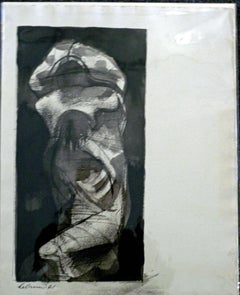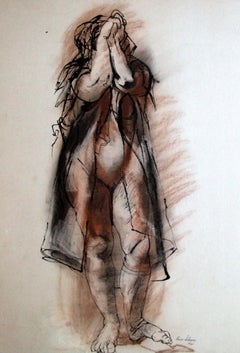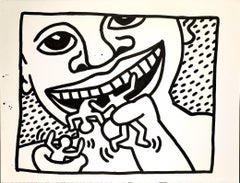Rico Lebrun Art
to
2
1
3
3
2
1
Abstract Figurative Lithograph
By Rico Lebrun
Located in Houston, TX
Black and white figurative abstract lithograph of two naked, crouching figures by California artist "Rico Lebrun," titled "Crouching Figures" and dated 1961. Additional writing on th...
Category
1960s Abstract Rico Lebrun Art
Materials
Lithograph
FIGURE STUDY
By Rico Lebrun
Located in Portland, ME
Lebrun, Rico. FIGURE STUDY. Ink and wash on heavy paper, 1961. Signed
and dated "'61" in the margin, lower left. 19 1/4 x 10 inches on a
sheet of handm...
Category
1960s Rico Lebrun Art
Materials
Ink
Female Figure - Ink and Crayon by Rico Lebrun - 1941
By Rico Lebrun
Located in Roma, IT
Female Figure is an original drawing realized in 1941 by Rico Lebrun in 1941.
Ink and crayon.
This drawing is hand signed and dated on lower right.
On the back embossed stamp of ...
Category
1940s Modern Rico Lebrun Art
Materials
Crayon, Ink
Related Items
Untitled, 1982 (Cannibal)
By Keith Haring
Located in Greenwich, CT
Untitled, 1982 is a sumi ink on paper, 38.25 x 50" image size, signed and dated verso 'SEPT.21 - 82 + K. Haring' and framed in a custom, gold-leaf frame.
Haring’s image of a man-eating monster is partly influenced by the artist Hieronymus Bosch as Haring often cited Bosch’s The Garden of Earthly...
Category
1980s Pop Art Rico Lebrun Art
Materials
Paper, Sumi Ink
The Abduction of the Sabine Women , a Renaissance drawing by Biagio Pupini
Located in PARIS, FR
This vigorous drawing has long been attributed to Polidoro da Caravaggio: The Abduction of the Sabine Women is one of the scenes that Polidoro depicted between 1525 and 1527 on the façade of the Milesi Palazzo in Rome. However, the proximity to another drawing inspired by this same façade, kept at the Ecole des Beaux-Arts, and to other drawings inspired by Polidoro kept at the Musée du Louvre, leads us to propose an attribution to Biagio Pupini, a Bolognese artist whose life remains barely known, despite the abundant number of drawings attributed to him.
1. Biagio Pupini, a Bolognese artist in the light of the Roman Renaissance
The early life of Biagio Pupini, an important figure of the first half of the Cinquecento in Bologna - Vasari mentions him several times - is still poorly known. Neither his date of birth (probably around 1490-1495) nor his training are known. He is said to have been a pupil of Francesco Francia (1450 - 1517) and his name appears for the first time in 1511 in a contract with the painter Bagnacavallo (c. 1484 - 1542) for the frescoes of a church in Faenza. He then collaborated with Girolamo da Carpi, at San Michele in Bosco and at the villa of Belriguardo.
He must have gone to Rome for the first time with Bagnacavallo between 1511 and 1519. There he discovered the art of Raphael, with whom he might have worked, and that of Polidoro da Caravaggio. This first visit, and those that followed, were the occasion for an intense study of ancient and modern art, as illustrated by his abundant graphic production.
Polidoro da Caravaggio had a particular influence on the technique adopted by Pupini. Executed on coloured paper, his drawings generally combine pen, brown ink and wash with abundant highlights of white gouache, as in the drawing presented here.
2. The Abduction of the Sabine Women
Our drawing is an adaptation of a fresco painted between 1525 and 1527 by Polidoro da Caravaggio on the façade of the Milesi Palace in Rome. These painted façades were very famous from the moment they were painted and inspired many artists during their stay in Rome. These frescoes are now very deteriorated and difficult to see, as the palace is in a rather narrow street.
The episode of the abduction of the Sabine women (which appears in the centre of the photo above) is a historical theme that goes back to the origins of Rome and is recounted both by Titus Livius (Ab Urbe condita I,13), by Ovid (Fasti III, 199-228) and by Plutarch (II, Romulus 14-19). After killing his twin brother Romus, Romulus populates the city of Rome by opening it up to refugees and brigands and finds himself with an excess of men. Because of their reputation, none of the inhabitants of the neighbouring cities want to give them their daughters in marriage. The Romans then decide to invite their Sabine neighbours to a great feast during which they slaughter the Sabines and kidnap their daughters.
The engraving made by Giovanni Battista Gallestruzzi (1618 - 1677) around 1656-1658 gives us a good understanding of the Polidoro fresco, allowing us to see how Biagio Pupini reworked the scene to extract this dynamic group.
With a remarkable economy of means, Biagio Pupini takes over the left-hand side of the fresco and depicts in a very dense space two main groups, each consisting of a Roman and a Sabine, completed by a group of three soldiers in the background (which seems to differ quite significantly from Polidoro's composition).
The balance of the drawing is based on a very strongly structured composition. The drawing is organised around a median vertical axis, which runs along both the elbow of the kidnapped Sabine on the left and the foot of her captor, and the two main diagonals, reinforced by four secondary diagonals. This diamond-shaped structure creates an extremely dynamic space, in which centripetal movements (the legs of the Sabine on the right, the arm of the soldier on the back at the top right) and centrifugal movements (the arm of the kidnapper on the left and the legs of the Sabine he is carrying away, the arm of the Sabine on the right) oppose each other, giving the drawing the appearance of a whirlpool around a central point of support situated slightly to the left of the navel of the kidnapper on the right.
3. Polidoro da Caravaggio, and the decorations of Roman palaces
Polidoro da Caravaggio was a paradoxical artist who entered Raphael's (1483 - 1520) workshop at a very young age, when he oversaw the Lodges in the Vatican. Most of his Roman work, which was the peak of his career, has disappeared, as he specialised in facade painting, and yet these paintings, which are eminently visible in urban spaces, have influenced generations of artists who copied them abundantly during their visits to Rome.
Polidoro Caldara was born in Caravaggio around 1495-1500 (the birthplace of Michelangelo Merisi, known as Caravaggio, who was born there in 1571), some forty kilometres east of Milan. According to Vasari, he arrived as a mason on the Vatican's construction site and joined Raphael's workshop around 1517 (at the age of eighteen according to Vasari). This integration would have allowed Polidoro to work not only on the frescoes of the Lodges, but also on some of the frescoes of the Chambers, as well as on the flat of Cardinal Bibiena in the Vatican.
After Raphael's death in 1520, Polidoro worked first with Perin del Vaga before joining forces with Maturino of Florence (1490 - 1528), whom he had also known in Raphael's workshop. Together they specialised in the painting of palace façades. They were to produce some forty façades decorated with grisaille paintings imitating antique bas-reliefs.
The Sack of Rome in 1527, during which his friend Maturino was killed, led Polidoro to flee first to Naples (where he had already stayed in 1523), then to Messina. It was while he was preparing his return to the peninsula that he was murdered by one of his assistants, Tonno Calabrese, in 1543.
In his Vite, Vasari celebrated Polidoro as the greatest façade decorator of his time, noting that "there is no flat, palace, garden or villa in Rome that does not contain a work by Polidoro". Polidoro's facade decorations, most of which have disappeared as they were displayed in the open air, constitute the most important lost chapter of Roman art of the Cinquecento. The few surviving drawings of the painter can, however, give an idea of the original appearance of his murals and show that he was an artist of remarkable and highly original genius.
4. The façade of the Milesi Palace
Giovanni Antonio Milesi, who commissioned this palace, located not far from the Tiber, north of Piazza Navona, was a native of the Bergamo area, like Polidoro, with whom he maintained close friendly ties. Executed in the last years before the Sack of Rome, around 1526-1527, the decoration of Palazzo Milesi is considered Polidoro's greatest decorative success.
An engraving by Ernesto Maccari made at the end of the nineteenth century allows us to understand the general balance of this façade, which was still well preserved at the time. The frescoes were not entirely monochrome, but alternated elements in chiaroscuro simulating marble bas-reliefs and those in ochre simulating bronze and gold vases...
Category
16th Century Old Masters Rico Lebrun Art
Materials
Ink, Gouache, Pen
Francis Bacon, signed 182/250 offset lithograph, study of the human body, 1980
By Francis Bacon
Located in Petworth, West Sussex
Rare, striking signed Francis Bacon lithograph from 1980, number 182 / 250.
Details of the work are as follows:
Francis Bacon (irish, 1909 ...
Category
20th Century Abstract Rico Lebrun Art
Materials
Lithograph
H 43.38 in W 32.63 in D 1 in
La Perruch et la Sirene
By (after) Henri Matisse
Located in Washington, DC
Artist: Henri Matisse (after)
Title: La Perruch et la Sirene
Portfolio: The Last Works of Henri Matisse
Medium: Lithograph
Date: 1958
Edition: 2000
Sheet Size: 14" x 30 3/4"
Signatur...
Category
1950s Abstract Rico Lebrun Art
Materials
Lithograph
I Want Pizza by Daniel Johnston Ink on paper
Located in Austin, US
I Want Pizza by Daniel Johnston
original ink on paper
measures 8.5" x 11"
Est. late 1970s
Signed au recto in ink by the artist
In excellent condition for its age with no rips on the paper
This drawing was part of Power Pathos, a 2006 Station Museum of Contemporary Art (Houston, TX) exhibit showcasing the work of five artists: Ron English, Clark Fox...
Category
Late 20th Century Outsider Art Rico Lebrun Art
Materials
Ink
Alexander Calder lithograph derrière le miroir
By Alexander Calder
Located in NEW YORK, NY
Alexander Calder Lithograph c. 1971 from Derrière le miroir:
Lithograph in colors; 15 x 11 inches.
Very good overall vintage condition; well-preseved.
Unsigned from an edition of u...
Category
1970s Abstract Rico Lebrun Art
Materials
Lithograph, Offset
Abstract Expressionist, Art Brut Lithograph, 'A Day Out'.
Located in Cotignac, FR
Abstract Expressionist lithograph on BFK Rives paper of a late 20th century work by French artist Eliane Larus.
A lively and highly colourful lithograph...
Category
Late 20th Century Abstract Expressionist Rico Lebrun Art
Materials
Lithograph
Judith Brenner, Sophie Dancing 1, Original Figurative Art, Abstract Sketch Art
By Judith Brenner
Located in Deddington, GB
Judith Brenner
Sophie Dancing 1
Original Figurative Drawing
Acrylic Paint, Pan Pastel, Ink and Watercolour Pencil on Paper
Sheet Size: 84.1cm x W 59.4cm x D 0.1cm
Sold Unframed
Please note that in situ images are purely an indication of how a piece may look.
Sophie Dancing 1 is an original nude drawing by Judith Brenner.The figure is continuously moving and the final work is a composition made in an attempt to capture the rhythm of the dance. This abstract-impressionistic work is evocative of Francis Bacon’s style...
Category
21st Century and Contemporary Abstract Impressionist Rico Lebrun Art
Materials
Paper, Pastel, Ink, Watercolor, Pen
Free Shipping
H 33.12 in W 23.39 in D 0.04 in
Olympische Spiele Muenchen (Foot) by Tom Wesselmann
By Tom Wesselmann
Located in Long Island City, NY
Artist: Tom Wesselmann (1931 - 2004)
Title: Olympische Spiele Muenchen (Foot)
Year: 1972
Medium: Lithograph Poster mounted on linen
Edition:...
Category
1970s Abstract Expressionist Rico Lebrun Art
Materials
Lithograph
Olympische Spiele Muenchen (The Runners) by Jacob Lawrence
By Jacob Lawrence
Located in Long Island City, NY
Artist: Jacob Lawrence (1917 - 2000)
Title: Olympische Spiele Muenchen (The Runners)
Year: 1972
Medium: Lithograph Poster mounted on linen
E...
Category
1970s Abstract Expressionist Rico Lebrun Art
Materials
Lithograph
Large 1960's California Pop Art Abstract Expressionist LA Lithograph John Altoon
Located in Surfside, FL
John Altoon (1925-1969)
UNTITLED, 1966, color lithograph, hand signed in pencil and inscribed trail proof II, sheet 29 ¾ x 41 ¼, printed by Gemini G.E.L.,...
Category
1960s Abstract Expressionist Rico Lebrun Art
Materials
Lithograph
Henri Matisse (after) Danseuse Creole
By (after) Henri Matisse
Located in Washington, DC
Artist: Henri Matisse (after)
Title: Danseuse Creole
Portfolio: The Last Works of Henri Matisse
Medium: Lithograph
Date: 1958
Edition: 2000
Frame Size: 21 1/4" x 17"
Sheet Size: 14" ...
Category
1950s Abstract Rico Lebrun Art
Materials
Lithograph
Rico Lebrun art for sale on 1stDibs.
Find a wide variety of authentic Rico Lebrun art available for sale on 1stDibs. You can also browse by medium to find art by Rico Lebrun in ink, lithograph, crayon and more. Much of the original work by this artist or collective was created during the 20th century and is mostly associated with the modern style. Not every interior allows for large Rico Lebrun art, so small editions measuring 20 inches across are available. Customers who are interested in this artist might also find the work of Alexander Archipenko, Frank Kleinholz, and Michael Hurson. Rico Lebrun art prices can differ depending upon medium, time period and other attributes. On 1stDibs, the price for these items starts at $875 and tops out at $3,760, while the average work can sell for $1,350.



